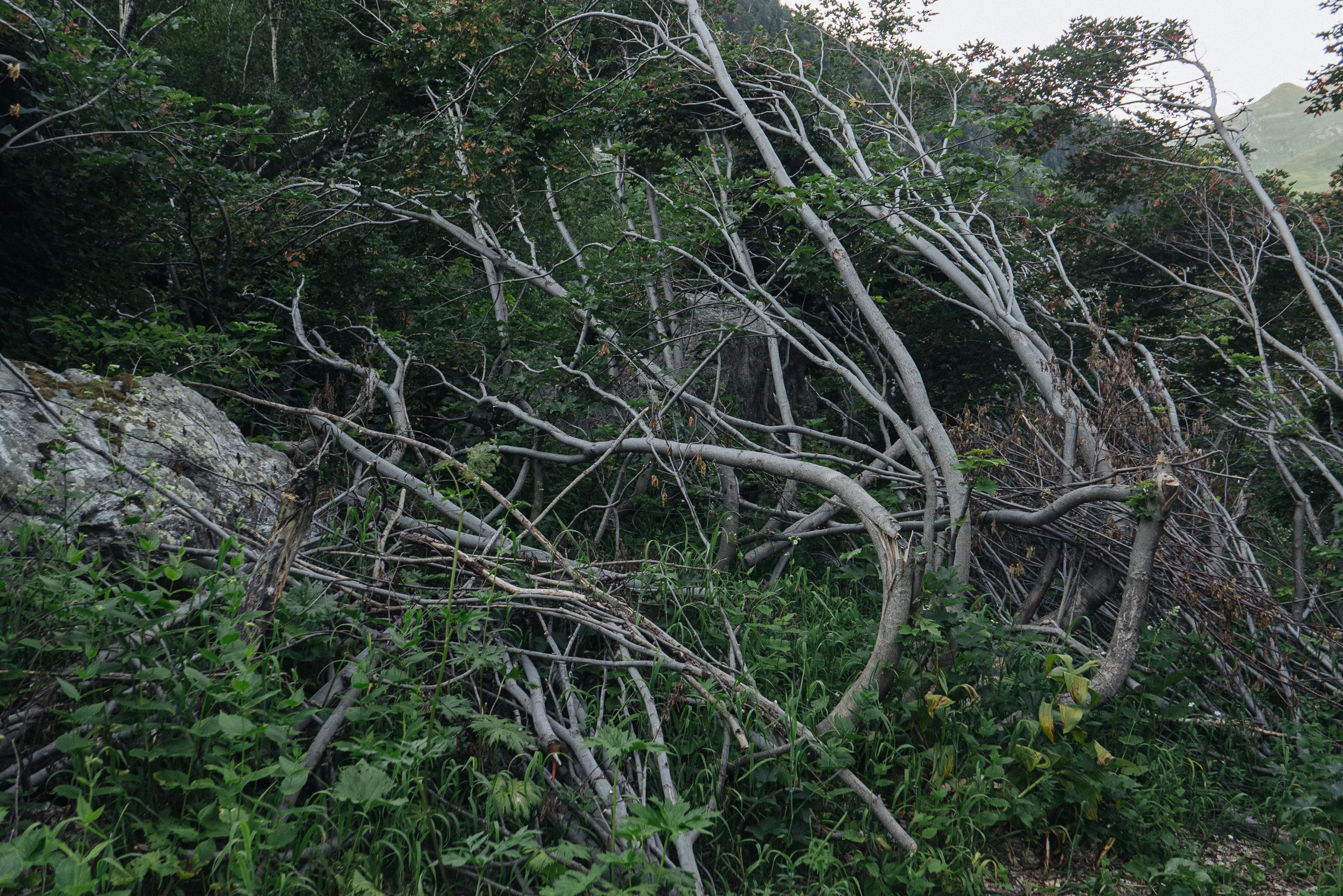Do you have a willow tree in your backyard and worry about it breaking? Are you considering planting a willow tree and want to know if they are fragile? Willows are considered one of the most beautiful trees, but can they withstand strong winds and rain? In this article, we discuss the strength of willow trees and how easily they break. We also explore how to strengthen the structure of a willow tree and ways to protect it from breakage.
Yes, willow trees have weak branches. As their wood is soft and brittle, their branches are prone to break easily.
Are Willow Trees Prone to Breaking?
Willow trees are known for their incredible flexibility and resilience, but they are still vulnerable to strong storms and winds that can cause branches to break or even the entire tree to be uprooted. While willow trees can often survive these events, they may be more likely to suffer damage than other types of trees.
The long, slender branches of willow trees are especially prone to breakage due to their reduced surface area. These branches are also less rigid than those of other tree species, which can cause them to bend or snap during strong winds or heavy snowfall. Additionally, willow trees tend to have a shallow root system which can make them more vulnerable to being uprooted in heavy winds.
In order to protect a willow tree from potential breakage, it’s important for it to be planted in an area that is sheltered from strong winds and heavy snowfall. If possible, planting the tree near a wall or fence can provide additional support during storms. Regular pruning can also help reduce the risk of breakage by removing any weak or dead branches before they become an issue.
Overall, while willow trees may be more prone to breakage than some other types of trees, taking the right precautions can help minimize the risk and ensure that your tree stays healthy and strong for many years to come.
What Causes Willow Trees to Break?
Willow trees are known for their delicate branches and high susceptibility to damage. Heavy winds, temperature fluctuations, and pests can all cause branches of the willow tree to break. When the branches become brittle, they are more likely to easily break under the pressure of strong winds or heavy snow. Temperature fluctuations can also cause willow trees to become weak and brittle, leading to branch breakage. Pests, such as aphids, can also weaken the branches of a willow tree by feeding on its sap and injecting toxins into its system. This can make a once-healthy tree vulnerable to breakage from heavy winds or snow.
It is important for homeowners with willow trees in their yards to take preventative measures against these causes of breakage. Regularly pruning the tree can help keep it healthy by removing damaged or dead branches that could easily snap under pressure. Additionally, treating your tree for pests with an insecticide can help protect it from infestations that could weaken its structure over time. Finally, ensuring that your willow tree has access to enough water during periods of drought can help keep its branches strong and less likely to be damaged in windy weather conditions.
Damage to Willow Trees Common?
Damage to willow trees is unfortunately a common occurrence. Willows are susceptible to a variety of pests and diseases that can cause significant damage. Some of the most common issues include fungal infections, insect infestations, and root rot. These problems can lead to discoloration, wilting, and death in extreme cases. Additionally, willow trees are vulnerable to physical damage from wind and storms, as well as from being struck by lawn care equipment or vehicles.
The best way to protect willows from damage is proper maintenance. Regular pruning and trimming of dead or diseased branches can help prevent the spread of infection throughout the tree. Additionally, keeping the area around the tree free of weeds and debris can help reduce the risk of pest infestation. If an infection occurs, it is important to contact an arborist or tree service professional as soon as possible to take steps towards treating the tree before it becomes too serious an issue.
Overall, while damage to willow trees is unfortunately common, proper maintenance and care can help reduce their vulnerability and protect them from further harm.
What Factors Can Make Willow Trees More Susceptible to Breaking?
Willow trees are particularly susceptible to breaking due to their shallow root systems and brittle branches. Wind, ice, and snow can also cause them to break. In addition, the growth of these trees is dependent on the soil and climate conditions in which they are planted. Poor soil or drought-like conditions can cause the bark of willow trees to become weak and brittle, making them more prone to breaking. Over-fertilization can also contribute to weakened bark, as too much fertilizer can lead to rapid growth and result in a weak structure. Finally, improper pruning techniques can reduce the resistance of the tree’s branches and make them more susceptible to cracking or breaking.
Overall, willow trees are vulnerable to breaking due to their shallow root systems and brittle branches. Poor soil conditions, excessive fertilizer, and improper pruning techniques can all contribute to a weakened structure that is more likely to break under pressure from wind, ice, or snow. Taking proper care of willow trees is important in order to prevent them from becoming susceptible to breaking.

Improving the Strength of Willow Trees
Willow trees are a popular choice for gardens, parks and other outdoor spaces due to their fast growth, graceful shape and ability to withstand harsh weather conditions. However, the strength of willow trees can be improved with a few simple steps. These steps include proper pruning, protecting against disease and pests, using proper soil and fertilizers, and providing adequate water and sunlight.
Pruning
Pruning is an important step in improving the strength of willow trees. Pruning helps remove dead or diseased branches as well as promote healthy growth by removing overcrowded branches. Pruning should be done when the tree is dormant in late winter before buds begin to form. It’s important to use sharp pruners or shears when trimming branches so that they don’t tear or break off.
Protecting Against Disease and Pests
Willow trees are susceptible to various diseases and pests such as aphids, mites, scale insects, borers and fungal infections. To protect against these threats it’s important to regularly inspect your tree for signs of infestation or infection such as discolored leaves or wilting branches. Removing affected branches promptly can help prevent the spread of disease or pest infestations. Additionally, applying a fungicide can help reduce the risk of fungal infections.
Soil and Fertilizers
When planting a willow tree it’s important to use well-draining soil that is rich in organic matter such as compost or peat moss. Additionally, using slow-release fertilizers at least once per year can help provide the nutrients needed for healthy growth. When applying fertilizer it’s important to follow manufacturer instructions carefully since too much fertilizer can cause damage to the tree’s root system.
Watering & Sunlight
Adequate water and sunlight are also essential for strong willow trees. During periods of drought it’s important to provide supplemental water so that the soil remains moist but not soggy. Additionally, willow trees should be planted in an area that receives full sun for at least six hours per day for optimal health. With proper care and attention your willow tree should thrive for years to come!
Common Reasons for Breakage in Willow Trees
Willow trees are known for their fragile branches, making them susceptible to breaking. Common causes of breakage in willow trees include heavy snow and ice, strong winds, disease, and poor pruning practices. When exposed to these environmental factors and other stressors, the branches of willow trees become weak and are more likely to break.
Heavy snow and ice accumulation on the branches of willow trees can be a major cause of breakage. The weight of the snow and ice can be too much for the thin branches to bear, causing them to snap or break off. Strong winds can also cause significant damage to willow trees by putting excessive strain on the branches or uprooting them entirely.
Disease is another common reason why willows may experience breakage. When a tree is suffering from an infection or infestation, its strength is compromised which makes it more prone to breaking under pressure from environmental stresses or physical damage caused by animals or people.
Finally, improper pruning techniques can lead to breakage in willow trees. If too much foliage is removed at once without proper technique, it can weaken the branch structure and make them more vulnerable when exposed to other environmental stresses such as wind or ice accumulation. For best results, it is always recommended that you hire a professional arborist if you plan on pruning your willow tree.
Preventative Measures for Willow Tree Breakage
The willow tree is a beautiful and majestic addition to any landscape. However, its branches can be fragile and prone to breakage. To prevent this from happening, it is important to take preventative measures. Proper pruning, regular maintenance, and proper watering are all essential for maintaining the health of a willow tree.
Pruning is an important part of keeping a willow tree healthy. Pruning should be done on a regular basis to keep the shape of the tree and remove any dead or damaged branches. For young trees, pruning should be done in late winter or early spring when the sap is running low and before new growth begins. For mature trees, pruning should take place in late summer or early fall when sap flow is at its highest.
Regular maintenance is also important for keeping a willow tree healthy. This includes removing any debris from around the base of the tree, such as leaves or twigs that could cause damage if left unchecked. Additionally, it is important to inspect the trunk for cavities that could potentially weaken the structure of the tree.
Finally, proper watering is essential for maintaining a healthy willow tree. During periods of drought or extreme heat, it may be necessary to water more often than usual in order to ensure that the tree receives enough water. If possible, try to water near the base of the trunk rather than overhead so that water can reach deeper into the soil where it can provide more nutrients for the roots and help prevent breakage due to drought stress.
By taking these preventative measures, you can help ensure that your willow tree remains healthy and strong for years to come.

Conclusion
Willow trees can be a great choice for those looking for a fast-growing, hardy tree to provide shade and privacy. While they are generally not prone to breaking, they can be damaged by strong winds or heavy snowfall. Proper care and maintenance of willow trees is important in order to ensure that they remain healthy and strong, and do not become susceptible to breakage. Pruning and staking, along with regular watering, fertilizing, and mulching will help keep them healthy and prevent them from becoming weak and brittle.
In conclusion, while willow trees are generally not known for being prone to breaking, it is possible if the tree is not properly cared for or exposed to extreme weather conditions. With proper care, however, willow trees can remain strong and healthy despite their fast-growing nature.

My interest in trees started when I first saw the giant sequoias in Yosemite.
I was a teenager then, and I remember thinking, “I need to learn more about this.”
That moment stuck with me.
A few years later, I went on to study forestry at Michigan Tech.
Since graduating, I’ve worked in a mix of hands-on tree care and community education.
I’ve spent over ten years helping people understand how to plant, maintain, and protect the trees in their neighborhoods.
I don’t see trees as just part of the landscape.
They are living things that make a real difference in our daily lives.
